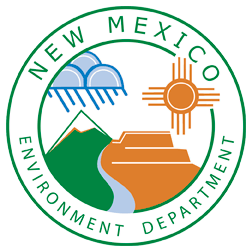The New Mexico Environment Department (NMED) Hazardous Waste Bureau (HWB) is issuing a response to the request submitted by Los Alamos National Laboratory (LANL) to treat four (4) pressurized gas containers, also known as flanged tritium waste container (FTWCs). The FTWCs were packaged in 2007. A later audit determined lead waste was also packaged with tritium, making the containers a mixture of hazardous waste and radioactive waste. The FTWCs became a pressurized gas hazard due to the breakdown of tritium occurring since initial packaging, which prevented the four containers from being repackaged and transported for disposal off site, and thus, is requiring onsite treatment.
The temporary authorization allows LANL to first depressurize the containers at technical area (TA)-54, then move the containers to TA-16, where the waste will be treated and then shipped to a final disposal site. LANL will perform the depressurization of one container at a time and is estimating 3-4 days to depressurize each container. The treatment will include depressurization and capture of the released gas. The entire depressurization operation will be monitored by both LANL and the EPA. Following depressurization of all four (4) containers at TA-54, the containers will be transported to the weapons engineering tritium facility (WETF) at TA-16. At WETF, the containers will be repackaged, and the lead component will be separated from the FTWCs containers. The lead portion, subject to hazardous waste jurisdiction, and the repackaged container(s) will be shipped off-site for final disposal at a licensed facility.
September 4, 2025 – NMED issued an Approval with Modifications to the Temporary Authorization to treat four (4) FTWCs Containers.
Upon review of the documentation provided by the Permittees, NMED finds the documentation sufficient to support the issuance of temporary authorization. NMED concurs that the risk of inaction is greater than the risk of action and the technical solution proposed by the Permittees is more protective of human health and the environment than inaction or further delay. The temporary authorization is effective for 180 days, starting on September 5, 2025, and expiring on March 4, 2026. The temporary authorization activities will be performed during appropriate weather conditions and air temperatures, with the following non-negotiable modifications:
- The Permittees shall ensure positive verification that the capture system AL-M1 has adequate capacity to fully and efficiently capture headspace gases. To prevent breakthrough, the Permittees will validate, between each FTWC depressurization evolution, that the AL-M1 loading ratings are not exceeded. Upon finding a loading risk, the Permittees will use an unloaded AL-M1 for the next FTWC.
- The Permittees shall change the administrative hard stop emissions limit from 8 mrem to 6 mrem to the maximally exposed individual for the entire FTWC treatment process. This is below the EPA’s CAP 88 standard.
- The Permittees shall notify the public and tribal communities in writing, in English and in Spanish, no less than three days prior to commencing operations to allow surrounding communities and persons time to adjust their activities in an abundance of caution as they deem necessary.
- Permittees shall communicate with the public and engage in tribal consultation following completion of the proposed activities. The Permittees shall provide meaningful public and government to government engagement. At a minimum, the Permittees shall conduct a post-activity meeting within 30 days of completing the treatment process and provide advance notification to the public about participation options. The Permittees shall provide audio and visual support during the meeting sufficient to allow unrestricted virtual attendance and commenting; and must provide information to be presented prior to the meeting for public access and review, including but not limited to sampling and modeling data. Within two days of this post-activity meeting, the Permittees shall post a recording of the public meeting. Within two weeks of this post-activity meeting, the Permittees shall post a comments and response table.
- Permittees must publish a final report documenting the treatment process and all analytical results, including summaries of activities, lessons learned, and photographic documentation of the process to the public, along with any other information provided to EPA or NMED to demonstrate adherence to permit and this temporary authorization’s conditions.
- In accordance with 40 CFR 270.42(a)(1)(ii), the Permittees must provide a notification of this permit modification to all persons on the LANL facility mailing list, maintained by the NMED Hazardous Waste Bureau, within ninety days of incorporation of this permit modification.
- The Permittees shall notify NMED, the EPA, tribal communities, and the public of any potential threat to public health within 15 minutes of any problems during the treatment process that result in an unanticipated release of tritium exceeding the conditions of this temporary authorization.
September 4, 2025 – NMED Approval with Modifications
August 27, 2025 – DOE Supplemental Information
August 22, 2025- DOE Criteria Response
August 20, 2025- DOE Public Meeting Roster
June 9, 2025 – After ensuring compliance with the applicable requests for Temporary Authorization regulations at 20.4.1.900 NMAC, incorporating 40 CFR §270.42, NMED has issued this response to the Temporary Authorization that was submitted by the Permittees.
While NMED finds that the Permittees request is consistent with the applicable requirements of 40 CFR §270.42(e), which allows for NMED to consider granting approval of the temporary authorization of a Class 2 modification meeting the criteria in §270.42(e)(3)(ii), however, there is significant public interest in this matter. Therefore, NMED will not act on the temporary authorization request until the following criteria are successfully met by the Permittees is provided in the letter listed below, but is summarized generally as:
- Independent Technical Review. Permittees shall obtain an independent technical review for alternative options for the depressurization of the FTWCs.
- Public Meeting. Meeting must include a review of the independent technical review, the preferred treatment process, and a discussion of the safety mechanism and contingencies to ensure the protection of human health and the environment during operations.
- Tribal Consultation. Permittees shall host a tribal consultation with interested tribal governments related to the independent technical review.
- Compliance Audit. Permittees shall retain an independent auditor to conduct a hazardous waste compliance audit of its operations.
To see the Permittees’ Request and NMED’s letter, click on the links below.
June 9, 2025 – NMED Response to Temporary Authorization Request
April 4, 2025 – DOE Notification of Planned Start of Activity
June 6, 2023 – DOE Public Outreach on FTWCs
January 28, 2022 – DOE Supplemental Information on Application for Treatment
December 13, 2021 – EPA Determination on the Definition of Treatment
October 28, 2021 – NMED Request RCRA Treatment Determination
September 3, 2020 – DOE Notification of Planned Start of Activity
March 9, 2020 – DOE Withdrawal and Resubmittal Temporary Authorization
June 20, 2019 – DOE Request for Temporary Authorization
LANL Hazardous Waste Facility Permit Mailing List
The New Mexico Environment Department (NMED) is required by regulation to maintain a Facility Mailing List as part of its oversight of the Los Alamos National Laboratory Hazardous (LANL) Waste Facility Permit (Permit). NMED, as well as the Department of Energy (collectively, the Permittees), use this list to inform stakeholders, including interested members of the public, of comment periods for permit modification requests and draft permits, and final NMED administrative actions on permit decisions, etc. If you wish to add your name to NMED’s LANL Facility Mailing List, please notify Siona Briley by email at siona.briley@env.nm.gov , or by postal mail at Siona Briley, New Mexico Environment Department-Hazardous Waste Bureau, 2905 Rodeo Park East, Bldg. 1, Santa Fe, NM 87505. Please include your name, email (preferred communication method to save resources) or postal mailing address, and organization, if any.
The Permittees are required per Permit Part 1, to maintain a separate email notification list. The Permittees use this list to notify members of the public concerning actions such as reporting planned changes, reporting anticipated noncompliance, etc. If you wish to subscribe to the Permittees’ email notification list.

